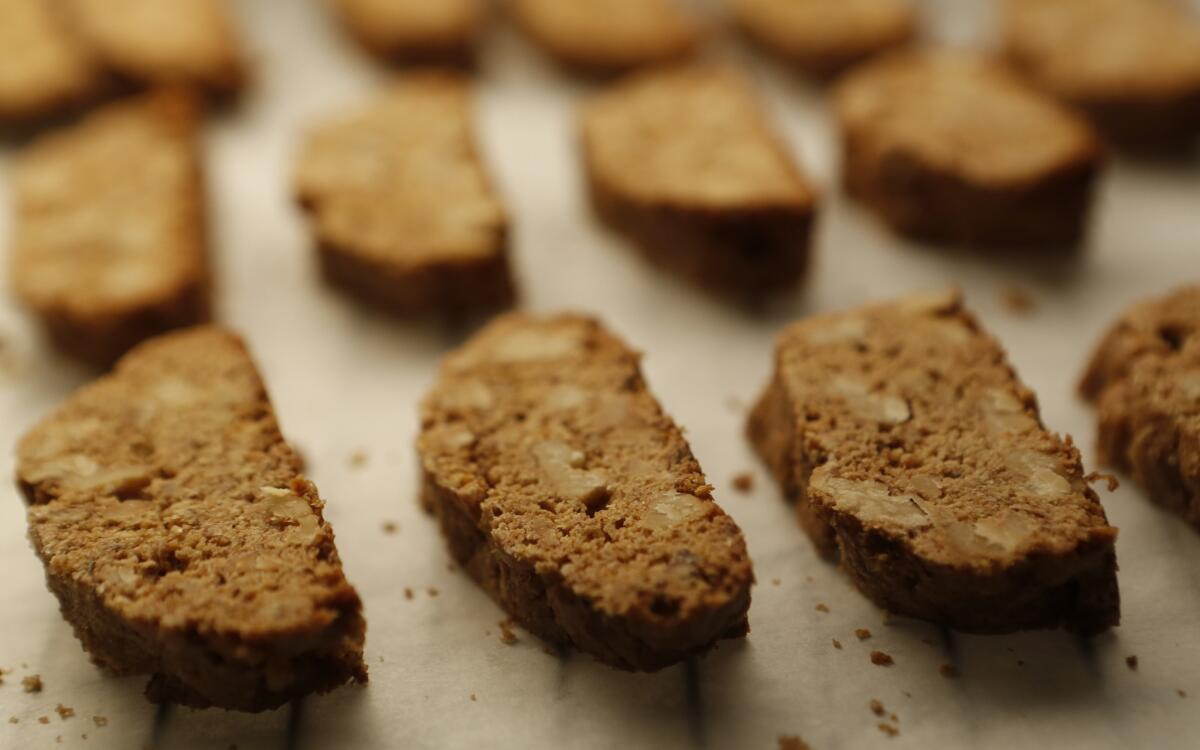Walnut spelt biscotti with olive oil

We all want to eat better, and most of us would love to have more meals with healthful and flavorful whole grains on our table. Yet, as a cookbook author specializing in them, whenever I ask during talks, “Did you cook some whole grains this week?” few hands go up in the room. And, as further prodding reveals, time or the lack of it seems to be the biggest hurdle.
It takes little to speed up your grain game. I spent the first part of my career working long and late hours as a news agency journalist. Still, whole grains were always on my table, for breakfast, lunch, dinner — and even for dessert. Here are five easy tricks:
1. Always have a few quick-cooking whole grains on hand. Today you can find many varieties, often gluten-free, on store shelves that can cook in 10 to 20 minutes, perfect for busy weeknights. This includes quinoa and also amaranth, buckwheat, millet and polenta or cornmeal. Not to forget farro (emmer wheat), trendy freekeh (toasted green wheat) and bulgur — which is called ancient fast-food for a reason. Last but not least, there’s also whole-wheat couscous, which needs nothing but a brief steaming to become a nourishing player on your mealtime table.
2. Store grains in individual Mason jars. This allows you to see at a glance what’s on hand and quickly choose a grain for dinner. For added ease, keep your favorite quick-cooking grains on an open kitchen shelf.
3. Prepare a large pot of slower-cooking whole grains on the weekend for later use. These include whole-wheat berries, spelt, rye and whole-grain barley. Cooking these hearty grains ahead enables you to work them into meals easily on busy nights. You can keep cooked grains at the ready in the fridge for up to seven days, or freeze them in portion sizes to always have on hand. (Two cups of raw grains will typically yield about six cups of cooked grains.)
4. Cooked grains keep in the freezer for months. You can defrost them overnight in the fridge, then briefly reheat them for dinner with 1/4 inch of water. Or cook them, straight from the freezer, in the microwave. (One cup of frozen grains needs only 1 to 2 minutes on high to be ready to eat.)
5. Be sure to soak slow-cooking grains overnight and cook them well, until some of them split and their starchy centers show. Don’t undercook these chewy whole grains. Why? Because when nicely plumped and supple, the kernels are much more appealing to eat — unless you love a mighty good chew.
Suggestions? Toss a cup of cooked grains into any soup or use them as a base for a more nourishing salad. Warm grains with milk for a quick breakfast that you can top with fresh fruit. Make grain burgers by adding grated vegetables, cheese, herbs and spices. Or add some cooked grains to pancake batter for brunch. You’ll be surprised how creative you can become once you have cooked grains at the ready.
In a large bowl, whisk together the flour, sugar, baking powder and salt. Make a well in the center. In a medium bowl, lightly beat the eggs with a fork. Gradually stir in the olive oil until well blended, followed by the limoncello, vanilla and zest. Pour the olive oil mixture into the center of the flour mixture. Using a whisk or a wooden spoon, and stirring from the center, gradually combine the ingredients to fully incorporate and form a sticky dough.
Add the nuts to the bowl. Using your hands, gently incorporate them into the dough while forming a ball. If the mixture becomes sticky, moisten your hands with water. Cover the bowl with a plate and set aside for 25 to 30 minutes.
Meanwhile, place a rack in the center of the oven and heat to 350 degrees. Line a large rimless baking sheet with parchment paper. Lightly grease the work surface with olive oil.
Cut the dough inside the bowl into 4 equal pieces. Gently form each piece into a log, about 9 inches long, pressing in any protruding nuts and moistening your hands with water if needed to keep the dough from sticking. Place the logs crosswise on the baking sheet, leaving at least 2 inches in between. Gently pat down the top of each log until it is about 13/4 inches wide. Sprinkle each log with a scant teaspoon sugar.
Bake until the logs firm up, small cracks appear on top and their edges turn golden brown, about 25 minutes. Remove the baking sheet from the oven and carefully slide the parchment paper with the logs onto a wire rack. Set aside to cool for 25 to 30 minutes.
Reduce the oven temperature to 300 degrees. Place a fresh sheet of parchment on the baking sheet. Transfer the logs to a cutting board (loosen them with a metal spatula if needed). Using a large serrated knife, cut each log diagonally into 1/2-inch-thick slices. Place the slices, cut side down, onto the baking sheet without touching.
Bake until the biscotti are fragrant, feel dry to the touch and start to brown around the edges, 30 to 35 minutes. Carefully slide the parchment paper with the biscotti to a wire rack to cool completely before storing.
Get our Cooking newsletter.
Your roundup of inspiring recipes and kitchen tricks.
You may occasionally receive promotional content from the Los Angeles Times.















